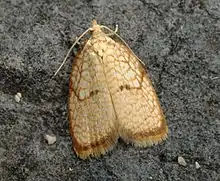Acleris forsskaleana
Acleris forsskaleana, the maple leaftier moth, is a moth of the family Tortricidae. It is found in Europe and North America[1] in woodlands and gardens.
| Acleris forsskaleana | |
|---|---|
 | |
| Scientific classification | |
| Kingdom: | Animalia |
| Phylum: | Arthropoda |
| Class: | Insecta |
| Order: | Lepidoptera |
| Family: | Tortricidae |
| Genus: | Acleris |
| Species: | A. forsskaleana |
| Binomial name | |
| Acleris forsskaleana | |
| Synonyms | |
| |
The wingspan is 12–17 mm. The ground colour of the forewings is yellowish underlying a reticulated darker pattern and a greyish suffusion across the disc. The moth flies from June to September from dusk onwards.
The main food plants in Europe are field maple (Acer campestre) and sycamore (A. pseudoplatanus); the larvae can also be found on Norway maple (A. platanoides).
The name honours Peter Forsskål.
References
- Opler, Paul A.; Kelly Lotts; Thomas Naberhaus. "Acleris forsskaleana". Butterflies and Moths of North America. Retrieved 12 February 2014.
External links
 Media related to Acleris forsskaleana at Wikimedia Commons
Media related to Acleris forsskaleana at Wikimedia Commons- waarneming.nl (in Dutch).
- Lepidoptera of Belgium
- Acleris forsskaleana at UKMoths
This article is issued from Wikipedia. The text is licensed under Creative Commons - Attribution - Sharealike. Additional terms may apply for the media files.